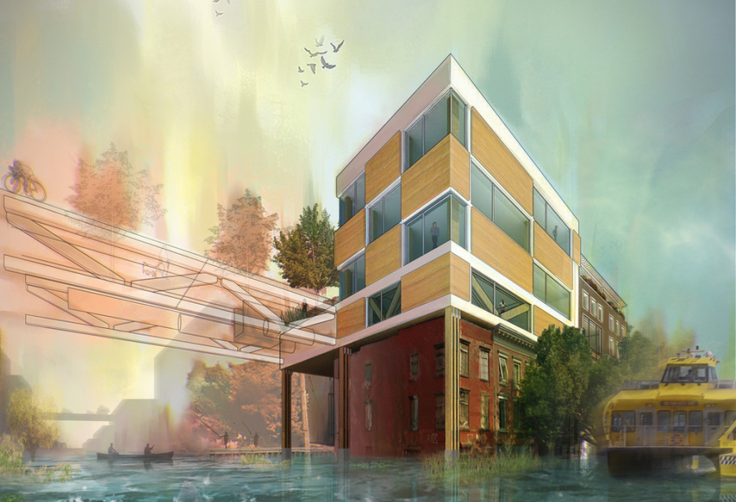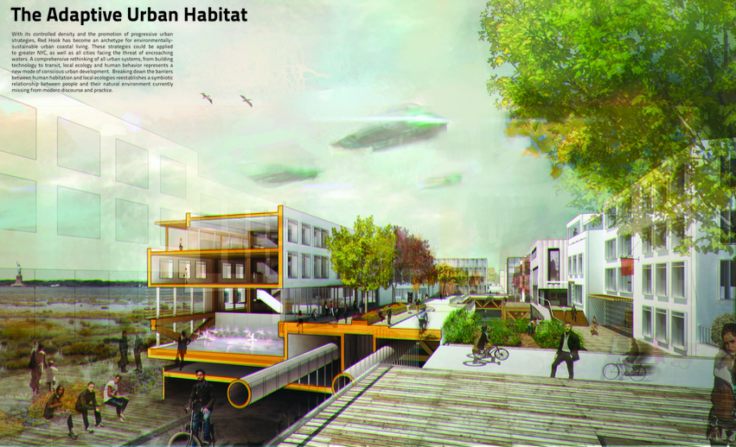One Year After Sandy, Many Ideas For Building More Resilient Coastal Communities

Nearly a year has passed since Superstorm Sandy lashed the East Coast, and the rebuilding has barely begun. As communities move ahead with that process, how can they ensure residents will survive the next tempest?
When she made landfall, Sandy was 1.8 million square miles in size, whipping storm surges up to 14 feet in New York City, and creating waves more than 32 feet high off the coast of New Jersey. In the wake of Sandy’s wrath, 159 people died, 8.5 million people lost power, 650,000 homes were damaged or destroyed, and $65 billion in damages and economic loss racked up.
The damage is slowly healing. New York City’s Metropolitan Transit Authority is repairing tunnels damaged by salt water. And while businesses on the Jersey Shore had a much harder summer than usual this year, it wasn’t a complete washout. But much remains to be done. As New York, New Jersey and other impacted areas look ahead to future storms and the prospect of climate change, it seems clear that mere restoration won’t do.
“Everyone is looking for fresh approaches, instead of just rebuilding what was there before Sandy,” says Steven Handel, an urban ecologist at Rutgers University.
In a post-Sandy era, “resiliency” is the new watchword. But how do you build a house -- and a neighborhood -- to ward off the next 100-year storm?
Raising the roof – and the floor
Daniel Horn remembers vividly the night Sandy arrived. He and most of his neighbors out in the village of Lindenhurst, on the south shore of Long Island, had ignored evacuation orders and decided to stay put. They remembered the dire predictions that previous year for Hurricane Irene, which turned out to be a dud. But Sandy quickly proved to exceed expectations.
“I was standing on my front stoop during the highest high tide, about 9 or 10 o clock at night,” Horn says. The sea had come to his doorstep. “I remember seeing the moon shining down on the water.”
Horn -- an architecture student at the New York Institute of Technology at the time -- and his family lost all of the belongings in their basement. They weren’t even the hardest hit. Of the 1,600 homes in the vicinity of the village, 1,400 experienced some flooding from Sandy, and 180 were substantially damaged or destroyed, Village building inspector Tom Maher told Newsday this past May.
Sandy made Horn rethink a project he had been working on to restore Newtown Creek, an estuary dividing Brooklyn and Queens that carries sewer overflow, runoff water and raw sewage into the East River. He realized he wasn’t giving enough consideration to the effect of storm surges like the one brought in by the superstorm. The storm also prompted Horn to co-found a group with other NYIT students called Operation Resilient Long Island, aimed at helping their communities bounce back.
“We had a very unique opportunity as architecture students to respond,” Horn says.
ORLI’s first project was relatively simple: The group created informative pamphlets and passed them out to locals in stormswept areas. The pamphlets provided details on how to get support from FEMA, the National Flood Insurance Program and various local agencies.
In those initial weeks after the storm, trying to sort out all the different information coming from official sources was confusing, Horn says. “I had that experience firsthand with my family.”
Horn and the other students in ORLI also wanted to envision the future of their neighborhoods, so they hosted a design contest called 3C: Comprehensive Coastal Communities. First prize went to “Mixed Paper,” a group formed by several recent graduates of Northeastern University’s architecture school. Their winning proposal, “Adaptive Urban Habitats,” tackles the future look of Red Hook, a Brooklyn neighborhood that suffered severe damage from the storm.

Mixed Paper imagines a progressive series of developments in Red Hook over the next 300 years. By 2100, every block of Red Hook would be connected through an elevated infrastructure. By 2300, the team envisions the local coastline to have returned to its original marshland composition. Red Hook residents would get around the boroughs by elevated rail and public water transit.
“We imagine the nature just slowly reappearing over time as the ground plane becomes vacated,” Mixed Paper team member Matt Stoner says.

Other finalists in the competition tackled other hard-hit areas in New York. The second-place-winning proposal in the competition, “Flexing with the Tide,” imagines a buffer zone of wetlands between the sea and the coastal Brooklyn neighborhood of Canarsie. Third-place winner “Hard-Core” would build elevated housing on the existing boardwalk in the Rockaways, anchored by stilts of concrete slabs firmly fixed into the ground.
Next, ORLI will be working with the 3C finalists to bring their ideas to local towns. Horn and cofounder Alex Alaimo also recently gave a presentation at an NYIT-hosted TEDx event.
“We talked about these issues from this higher standpoint, like: how do we educate the public and help them to build with modern-day techniques? How do we build with resiliency in mind?” Horn says.
Changing the landscape
The U.S. Department of Housing and Urban Development HUD’s Rebuild By Design contest involves projects on a slightly bigger scale.
“Rebuild By Design is not setting out to solve a regional problem with a single solution — changing a city's building code or engineering a ‘superdam,’” NYU sociology professor (and the contest’s research director) Eric Klinenberg and HUD advisor Henk Ovink wrote in Atlantic Cities in September. “Instead, it will be a dynamic, adaptive process, at the end of which will emerge a catalog of designs that address specific challenges and that can be implemented across the region.”
In August, HUD selected 10 finalist teams, most of which are partnerships between universities and architectural firms. The teams all drew up three different proposals, one of which will be selected for further development in late October.
Karen O’Neill and Steven Handel, professors of sociology and urban ecology, respectively, at Rutgers University, are members of one of the 10 finalist teams, working in partnership with the Massachusetts-based architects at Sasaki Associates. They’re focusing on New Jersey, and have taken to calling themselves the “beach team.”
“We see the beach not just as the strip of sand, but extending inland as well,” O’Neill says.
Mitigating flooding from storms means looking not just at the immediate coast but also at areas further inland. One area of focus for the Rutgers-Sasaki team is how drainage systems handle excess water from storm surges as well as thunderstorms.
Part of rebuilding coastlines involves recognizing the role nature can play in revitalizing and protecting areas. Native plants can help stop the erosion of dunes, soak up excess water like sponges -- often for much less money than the lawn grass or ornamental flowers you get at Home Depot.
“We rely on coastal habitats in so many ways,” Handel says. “Salt marshes clean the water and act as nurseries for shellfish and finfish, for example. They’re not just for charm and beauty, but economically important as well. People go to the coast to enjoy clean water. Without these habitats, the water won’t be as clean.”
Handel is urging towns to consider adding native plants wherever possible -- on beaches, on the median strips of roads, or even abandoned lots.
“We’re looking at making streets greener, literally,” Handel says.
Balancing the human interest
Some places affected by Sandy may be too precarious to rebuild upon. New York Governor Andrew Cuomo has already started making offers to buy out homeowners in certain communities on Staten Island and other stormswept areas.
“There are some parcels that Mother Nature owns,” Gov. Cuomo said in his State of the State speech in January. “She may only visit once every few years, but she owns the parcel and when she comes to visit, she visits.”
The question of where not to rebuild is “super-delicate,” O’Neill says. Any perception that local or federal governments are abandoning communities would be terrible, from a public relations standpoint, so most designers “have vowed we’re not going to use the word ‘retreat’.”
As a sociologist, O’Neill is particularly interested in listening to residents and figuring out what they want and need. It’s a tricky thing to balance resilient, ecologically sustainable design with a community’s desires and history. Luckily, the architects and designers aiming to rebuild after Sandy seem to be approaching matters with some sensitivity, according to O’Neill.
HUD “is trying to avoid some of what has happened in the past, where the experts swoop in and tell people what to do,” O’Neill says. “After Katrina, the Urban Land Institute came in with this top-down statement saying people just shouldn’t be living here, and that drove the designers out of town.”
Implementation
While these regional changes could take years to put in place, many homeowners in Sandy-hit areas are already feeling the pressure to refurbish. FEMA has been redrawing its flood maps for much of the country, and it released preliminary updated maps for New York and New Jersey this past summer. Many residents have suddenly found themselves in at-risk flood zones, or found that the estimated storm surge for their area has risen much higher.
The updated maps and storm surge estimates mean that many homeowners on the coast may have to hoist their houses up by as much as 8, 12 or 15 feet. A clause in the Flood Insurance Reform Act passed by Congress requires homeowners in FEMA-designated flood-risk areas to buy flood insurance, and if the homes are not raised above new storm surge estimates, residents could see their premiums spiral to tens of thousands of dollars a year.
“Raising a home is as complicated as it sounds,” Bloomberg Businessweek reporter Anne Linskey wrote in August. “Water, sewer, gas and electricity all have to be disconnected. Workers dig to the foundation, run steel beams beneath the ground floor, then slowly uproot the structure with hydraulic jacks. The house is then set back down on a newly built perch.”
Even if towns manage to comply with the new FEMA flood maps, some are worried that neighborhoods could become disjointed and lose their character. If the Joneses raise their house up 8 feet, while the Smiths next door jack up their residence by 15 feet, and so on, blocks could start taking on a kind of “sawtooth” pattern.
“It’s dawning on people that even if you elevate the houses, you don’t necessarily know what your neighbor’s place is going to look like,” O’Neill says.
Communities may also have to take a closer look at their building and zoning codes. Horn points to the neighborhood of Breezy Point in Queens. A fire ripped through the place the night that Sandy made landfall, eventually destroying more than 120 homes. Part of the reason the fire spread so easily was due to Breezy Point’s density; houses were crammed next to each other, sometimes with only one or two feet separating them.
“You have to spread these homes out more so fires can’t have the ability to jump from home to home,” Horn says. “Especially since the high winds from a hurricane make it easier for these fires to spread.”
Horn thinks back to a year ago, with the water lapping at his front stoop. Some neighbors have rebuilt their houses, while others are still unoccupied. Luckily, Sandy didn’t damage his family’s home as badly as it could have.
“I think Mother Nature spared me some major damage so I could focus my time on rebuilding my community,” Horn said.
© Copyright IBTimes 2024. All rights reserved.




















